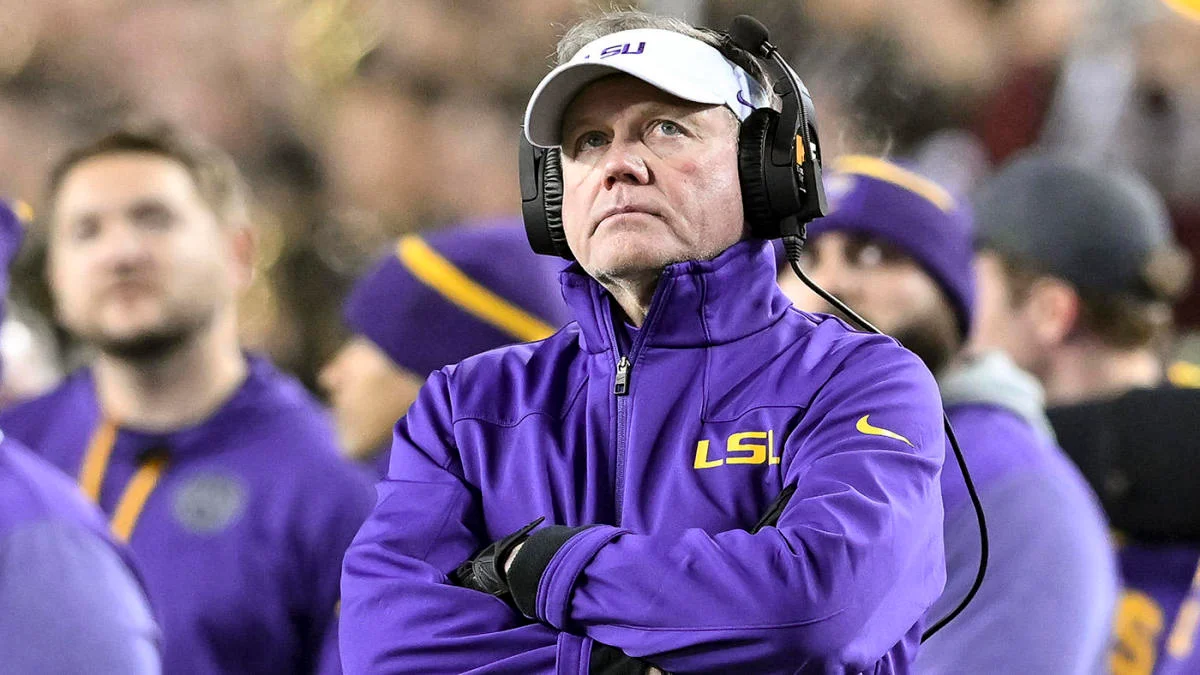
From the moment Brian Kelly was introduced as the head coach of LSU, he emphasized the importance of recruiting within the state of Louisiana. During his introductory press conference, he highlighted his commitment to local recruitment. This strategy had brought him notable success, such as securing Logan Diggs from Rummel for Notre Dame. Kelly outlined his vision for building the LSU roster: focus on in-state recruitment, develop homegrown talent, and strategically use the transfer portal to supplement the team.
Throughout his tenure at LSU, Kelly has remained steadfast in this approach. His consistency was evident just a few months ago when he reiterated his strategy. Kelly reflected on his plan: “The business plan has always been to pull our base here in the state of Louisiana, develop high school players, and by doing so, build relationships, trust, and loyalty within the program. This doesn’t exclude using the transfer portal; it means being strategic and utilizing it when necessary.”
Brian Kelly’s approach to roster building has been a frequent topic of discussion. Recently, his strategy was scrutinized again following his comments to Jacques Doucet, who asserted, “We’re not gonna buy a player.” Although Kelly provided a detailed, context-rich response, the focus quickly narrowed to that single statement, overshadowing his broader message.
Questions are always asked about Brian Kelly’s plan for building the LSU roster, which revolves around recruiting Louisiana, developing local talent, and supplementing through the transfer portal. While the strategy sounds promising, it’s still uncertain if it will be effective.
We haven’t seen a large enough sample size yet to make a definitive judgment. This year will be particularly revealing. My thoughts turned to this topic today because ESPN released its newcomer class ranking, combining a school’s recruiting class with its transfer acquisitions, essentially a blended ranking focusing on the new talent joining the roster. LSU ranked 16th on this list.
At first glance, some might be underwhelmed by the 16th-place ranking. However, I see this as enormously validating Brian Kelly’s approach. Allow me to explain.
Texas is the top-ranked team on this list, and it has been investing heavily in the transfer portal to win immediately. Ohio State comes in at number two, with Ryan Day facing significant pressure after not beating Michigan for three years and watching them win a national title. The urgency for Ohio State to succeed is palpable, especially with the rivalry dynamics.
Ole Miss, ranking third, is another example we’ve discussed extensively. They are heavily leveraging the portal this year, aiming for immediate impact. Similarly, Miami is fourth, with Mario Cristobal under pressure to deliver results now. Oregon, ranked fifth, is preparing for its transition into the Big Ten.
These rankings illustrate the different pressures and strategies at play. While some schools invest heavily in the transfer portal to achieve quick success, LSU’s approach under Brian Kelly reflects a more balanced and sustainable strategy. Whether this will prove successful remains to be seen, but the initial signs are encouraging.
There’s a lot of pressure on several programs right now. Alabama, ranked sixth, is an obvious case. With the departure of legendary head coach Nick Saban and a massive exodus of players, they had to bring in many recruits.
Similarly, Texas A&M, ranked seventh, faces the same scenario. They fired their head coach and lost 30 players. Colorado, ranked eighth, has also experienced a substantial exodus year after year. But what stands out here is what we’re not discussing: consistently dominant teams. Alabama has been exceptional, but their situation with Saban’s departure makes them an outlier. Let’s consider the best program in college football over the last half-decade. Who’s that? It’s Georgia. Georgia ranks 12th on this list. Is anyone worried about Georgia’s roster? I’m not.
The reason is simple: Georgia consistently produces top-tier recruiting classes and supplements through the portal as needed. This is precisely the strategy Brian Kelly advocates. To illustrate this further, let’s look at some numbers: In 2022, Brian Kelly’s first year at LSU, their transfer class was ranked third in the country, with 15 players signed through the portal. Their high school recruiting class was ranked 12th. In 2023, LSU’s transfer class was ranked fifth, with 13 players signed, while their high school class jumped to sixth.
This year, however, LSU’s transfer class is ranked 41st in the country. At first glance, this might seem concerning. However, it’s essential to understand the context and the strategy behind these numbers. Of course, it would have been great to secure Dominic Williams or Simeon Barrow, two starting-caliber defensive linemen. However, even with their addition, LSU’s ranking might only improve from 45th to 38th. That’s still far from the top.
LSU had eight commitments from the transfer portal and another top-10 high school class, ranking seventh. This positioning highlights Brian Kelly’s strategy. LSU’s 16th place on the newcomer list validates Kelly’s plan. He doesn’t aim to top the transfer portal rankings because leading in that area often signals massive roster turnover, which contradicts his core philosophy: recruit Louisiana and develop homegrown talent.
Kelly has undoubtedly recruited Louisiana effectively. Over the past three years, there has been a significant increase in the number of players from the state compared to other states. This marks a notable shift from Kelly’s first year, where LSU’s class included recruits from numerous states, assembled by Brian Polian.
I’ve emphasized this repeatedly, but it’s worth noting again. Brian Kelly is successfully building the foundation he envisions. The real question is whether this strategy will translate into wins. Look at the programs ahead of Georgia in the newcomer class rankings: Cal, Louisville, Michigan State, and Colorado. These aren’t models LSU aims to follow.
Georgia, on the other hand, recruits within its state and supplements with the portal. This aligns with my long-standing point that LSU has a unique advantage. LSU is one of only three programs in the country situated in a talent-rich state without significant in-state competition.
Florida has multiple Power Five programs and heavy competition. Alabama has both Alabama and Auburn. Texas is crowded with Texas, Texas A&M, Texas Tech, SMU, Baylor, and TCU. But LSU stands alone in Louisiana. Players like Will Campbell, who could have transferred for a higher price, choose to stay because they want to be LSU Tigers. This is LSU’s inherent advantage, shared only by Georgia and Ohio State.
They aren’t competing at the same level when comparing Georgia Tech to Georgia. Georgia is the premier program in a talent-rich state, enjoying little in-state competition. Similarly, Ohio State dominates its local recruiting landscape. Many variables remain uncertain, including NIL, the transfer portal, and the upcoming 12-team playoff. However, if Brian Kelly’s stated goal is to recruit and develop, the focus should be on maximizing the potential of players like Jacobian Guillory and Jalen Lee, both fifth-year players.
Kelly must also develop talents like Greg Penn and Harold Perkins, a third-year player known for his exceptional abilities on the edge. Turning Perkins into a versatile, every-down linebacker represents actual development. Freshman Javien Toviano’s progress will be another indicator of the program’s developmental success. A former five-star recruit, Sage Ryan, returns for another season, likely playing in a more natural position. Assessing his development will be crucial.
Brian Kelly has consistently emphasized recruiting and developing high school talent. The high school class rankings under Kelly have been impressive: 12th, 6th, and 7th. Additionally, the number of transfer portal recruits has decreased from 15 to 13 to 8, reflecting a strategic shift towards high school recruitment with supplemental portal additions. Kelly’s approach clearly aims to build a sustainable program through long-term player development rather than relying heavily on the transfer portal.
I understand. Now that we’re in year three, the critical question is: how well has this talent been developed? This year will provide a crucial three-year sample to evaluate whether Brian Kelly’s model will succeed or if LSU needs to adopt a different approach, like the aggressive transfer portal strategies seen at Ole Miss, Texas, and other top programs. Right now, it’s too early to definitively know which model works best in the era of the transfer portal and NIL.
Brian Kelly has clearly outlined his approach, and the newcomer class rankings I saw today, with LSU at 16th, reflect his plan in action. Being lower on that list is a positive sign that LSU isn’t over-relying on the portal.
For instance, Louisville is ranked higher than LSU. Does that mean Louisville is competing on the same level as LSU? Not at all. Louisville’s high ranking is due to the signing of 20 players from the portal, which inflates their position. This season will be fascinating, not just because of the loss of key players like Jayden Daniels, Malik Nabors, and Brian Thomas Jr., but also as a test case to see if Brian Kelly’s developmental model is effective and sustainable.
The rankings confirm that Kelly is building the program as intended. This year, we will begin to discover whether his approach can lead LSU to success at the highest level.









